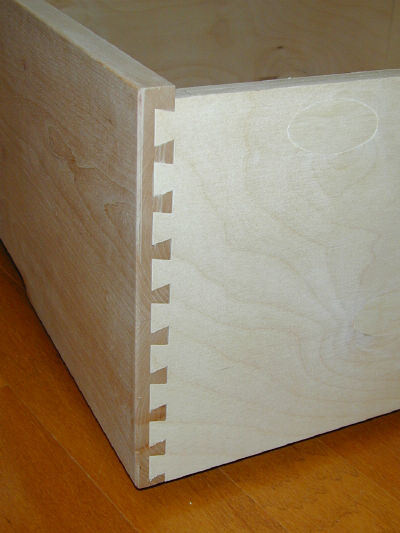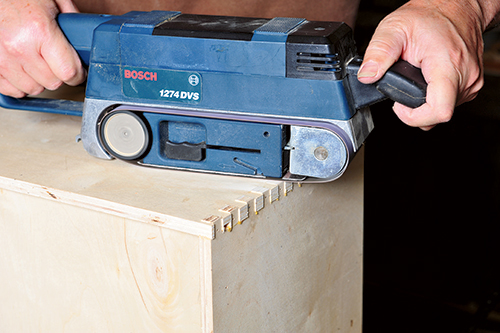Are you wondering if you can dovetail plywood? Well, you’ve come to the right place! Dovetailing is a popular woodworking technique that adds strength and beauty to joinery. But can you achieve the same results with plywood? Let’s find out!
Now, you might be thinking, “Can you really dovetail plywood?” The answer is both yes and no. While traditional dovetail joints are commonly used with solid wood, plywood presents a unique challenge due to its layered construction.
But don’t worry, because in this article, we’ll explore the possibilities of dovetailing plywood. We’ll discuss the potential issues, alternative techniques, and expert tips to help you create strong and aesthetically pleasing connections with this versatile material.
So, join us on this woodworking adventure as we unravel the secrets and techniques of dovetailing plywood. Whether you’re a beginner or a seasoned DIYer, you’ll discover valuable insights to take your woodworking skills to the next level. Let’s dive in!

**Can You Dovetail Plywood?**
Introduction:
When it comes to woodworking, dovetail joints are renowned for their strength and beauty. However, dovetailing is typically associated with solid wood, and many craftsmen wonder if it is possible to dovetail plywood. In this article, we will explore whether dovetailing can be done on plywood and discuss the benefits and challenges it presents. So, if you’re curious about expanding your joinery skills using plywood, keep reading to find out more.
Can You Dovetail Plywood?
Plywood is a versatile and commonly used material in woodworking projects, known for its strength, stability, and affordability. However, due to its construction, which consists of thin layers of wood glued together, dovetailing plywood does present some challenges. The main concern lies in the fact that plywood’s layers can be prone to splitting and chipping when cutting the dovetail joints.
Nevertheless, while dovetailing plywood can be more challenging, it is certainly possible to achieve successful results with the right techniques and tools. One key consideration is the type of plywood used, as some varieties have higher quality surface veneers that are better suited to dovetailing. It is recommended to choose plywood with a thicker top layer to minimize the risk of splitting.
Another crucial factor to consider is the dovetailing method employed. While traditional hand-cut dovetails may be more challenging with plywood, using a router and a dovetail jig can make the process much more manageable and precise. With the appropriate setup, a router can cut cleaner and more consistent dovetails in plywood, ensuring a strong and aesthetically pleasing joint.
Dovetailing Plywood: Challenges and Solutions
1. Layer Splitting: One of the primary challenges when dovetailing plywood is the risk of splitting or chipping the layers. To overcome this, consider using masking tape along the cut lines to reduce tear-out. Additionally, using a sharp, high-quality router bit can help minimize the chances of splitting.
2. Limited Glue Surface: Another consideration is the limited surface area available for gluing in plywood due to its layered construction. To ensure a strong joint, consider using reinforcing methods such as adding splines or biscuits in addition to the dovetail joints.
3. Veneer Tear-Out: The thin surface veneer of plywood can be prone to tear-out when cutting the dovetails. Using a backing board or a zero-clearance insert on the router table can help support the plywood and prevent tear-out, resulting in cleaner cuts.
Benefits of Dovetailing Plywood
Despite the challenges, dovetailing plywood offers several advantages, making it worth considering for certain projects:
- Strength: Dovetail joints are known for their exceptional strength and durability. By dovetailing plywood, you can create strong and reliable joints that will stand the test of time.
- Visual Appeal: Dovetail joints add a touch of elegance and sophistication to any woodworking project. By incorporating dovetails in plywood, you can elevate the aesthetic appeal of your designs.
- Cost-Effectiveness: Plywood is generally more affordable than solid wood, making it a cost-effective option for larger projects where solid wood may be prohibitively expensive.
- Stability: Plywood’s layered construction minimizes the risk of warping and movement, resulting in stable and reliable joints.
Tips for Dovetailing Plywood
1. Choose the right plywood: Opt for plywood with thicker top layers and high-quality surface veneers to minimize splitting and achieve better dovetail results.
2. Use a router and dovetail jig: Utilize a router and dovetail jig to ensure precision, consistency, and cleaner cuts when dovetailing plywood.
3. Consider reinforcing methods: To increase the overall strength of the joints, incorporate reinforcing elements such as splines or biscuits in addition to the dovetails.
4. Take precautions against tear-out: Use masking tape and a backing board or zero-clearance insert to reduce the risk of tear-out when cutting the dovetails.
5. Practice and experiment: As with any woodworking technique, practice is key. Consider experimenting with scrap pieces of plywood before working on your final project to refine your skills.
Conclusion:
Dovetailing plywood is indeed possible, albeit with some challenges. By selecting the right type of plywood, utilizing the appropriate tools and techniques, and taking the necessary precautions, craftsmen can achieve strong and visually appealing dovetail joints in plywood. While it may require some additional considerations and practices compared to solid wood, the benefits in terms of strength, cost-effectiveness, and stability make it a worthwhile endeavor. So, if you’re looking to expand your woodworking repertoire, don’t hesitate to explore the possibilities of dovetailing plywood!
Can You Dovetail Plywood? – Key Takeaways
- Dovetail joints are commonly used in woodworking to join two pieces of wood together securely. However, dovetailing plywood can be tricky because plywood is made up of layers and the edges can be fragile.
- It is possible to dovetail plywood, but it requires careful planning and preparation. You may need to reinforce the plywood edges or use a different type of joint depending on the thickness and quality of the plywood.
- When dovetailing plywood, it is important to use the correct tools and techniques. A router with a dovetail bit and a dovetail jig can help you achieve precise and clean dovetail joints.
- Before starting the dovetailing process, make sure to measure and mark your plywood accurately. This will ensure that your joints fit together properly and create a strong connection.
- Practice and patience are key when learning to dovetail plywood. It may take some trial and error to get the technique just right, but with practice, you can achieve beautiful and strong dovetail joints on plywood.
Frequently Asked Questions
Plywood is a versatile material commonly used in construction and woodworking projects. One technique often used with plywood is dovetailing, where two pieces of wood are joined together with interlocking shapes. Below are some common questions and answers related to dovetailing plywood.
Q1: What is dovetailing?
A1: Dovetailing is a woodworking joinery technique where two pieces of wood are interconnected using interlocking cuts or shapes. The resulting joint is strong and resistant to pulling or twisting forces. Dovetail joints are commonly used in constructing cabinets, drawers, and other furniture pieces.
A dovetail joint typically consists of a series of trapezoidal or triangular-shaped “tails” on one piece of wood that interlock with corresponding “pins” or “sockets” on the other piece of wood. This creates a secure, interlocking connection between the two pieces, ensuring stability and strength.
Q2: Can you dovetail plywood?
A2: Yes, you can dovetail plywood. While the interlocking nature of dovetail joints is commonly associated with solid wood, it is also possible to create dovetail joints with plywood. Since plywood consists of multiple layers of wood glued together, the joint can be formed by cutting through these layers in the desired dovetail shape.
However, it’s important to note that dovetailing plywood can be more challenging compared to solid wood due to the plywood’s layered structure. Care must be taken to avoid tear-out or damage to the plywood layers while cutting the dovetail shapes. Using sharp tools and taking proper precautions will help achieve clean and precise dovetail joints in plywood.
Q3: What are the benefits of dovetailing plywood?
A3: Dovetailing plywood offers several advantages. First, it adds strength and stability to the joint, making it ideal for applications where durability is important. The interlocking nature of the dovetail joint increases the surface area of contact between the two pieces, enhancing the overall strength of the connection.
Second, dovetail joints are aesthetically pleasing and often used to showcase craftsmanship. The visible interlocking shapes add visual interest to the project and can elevate the overall look of the finished piece. In addition, dovetail joints provide a more professional and high-quality appearance compared to alternative jointing methods.
Q4: What tools are needed for dovetailing plywood?
A4: Dovetailing plywood requires a few key tools. You will need a dovetail saw or a coping saw to cut the dovetail shapes. These saws have thin blades that can make precise cuts in the plywood. Additionally, a chisel will be necessary to remove the waste material between the dovetails and create clean, precise joinery.
Other useful tools may include a marking gauge or a pencil to mark the areas to be cut, a mallet to gently tap the chisel, and a combination square to ensure accurate measurements and right angles. It’s important to have sharp and properly maintained tools to achieve precise cuts in the plywood and create clean dovetail joints.
Q5: Are there different types of dovetail joints for plywood?
A5: Yes, there are different types of dovetail joints that can be adapted for use with plywood. Some common types include the through dovetail joint, half-blind dovetail joint, and sliding dovetail joint.
The through dovetail joint is visible on both sides of the joined pieces and is often used in applications where the joint will be exposed, such as in box corners or drawer construction. The half-blind dovetail joint hides the joint from one side, making it suitable for applications where a seamless appearance is desired, like dovetailed drawer fronts. The sliding dovetail joint is used to join two pieces of wood at right angles, such as in the construction of shelves or partitions.
These types of dovetail joints can be adapted to work with plywood by adjusting the cutting depths and sizes of the dovetail shapes to suit the thickness and composition of the plywood being used.

Summary
So, can you dovetail plywood? The answer is yes! Dovetail joints work well with plywood, but there are a few things to consider. First, use a quality plywood with smooth edges. Second, make sure you have the right tools and techniques for cutting dovetails. With some practice, you can create strong and beautiful dovetail joints with plywood.
In conclusion, dovetailing plywood can be a great way to create strong and visually appealing joints. Just make sure you choose the right plywood, use the correct tools, and practice your cutting techniques. With these steps, you’ll be able to master the art of dovetailing plywood in no time!
source https://thehabitofwoodworking.com/2023/can-you-dovetail-plywood/

No comments:
Post a Comment